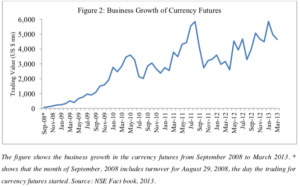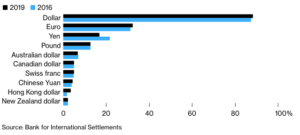Foreign exchange markets (Forex) or Currency Trading Market are one of the most important decentralized financial markets in the world. It promotes trade, investment and risk sharing across borders. FX is also the most liquid market and arguably the largest in the world. According to the BIS (Bureau of International Settlements) triennial report of 2010, Forex market had a daily turnover of $ 4 trillion.
Currency Futures in India
In the financial year 2007-08, the Reserve Bank of India had set up a working group for the introduction of currency futures to put forth an appropriate framework to implement the proposal that should be in line with the present regulatory framework.
In April 2008, Reserve Bank of India (RBI) and Securities and Exchange Board of India (SEBI) jointly formed a Standing Technical Committee (STC) to institute rules and observe the operation of Exchange Traded Currency Derivatives (ETCD). STC submitted its report on May 29, 2008 which formulated the framework for the launch of ETCD regarding the eligibility criteria for the existing as well as the new exchanges and their clearing corporations, eligibility criteria of their members, risk management, product design, surveillance mechanisms and other related measures.
The membership criteria for the currency futures segment would be different from that of the equity derivative segment. The banks which are authorized by the RBI under section 10 of the Foreign Exchange Management Act (FEMA), 1999 as ‘Authorized Dealers Category – 1 Bank’ were allowed to be the trading and clearing members of the currency futures market on their account and on the behalf of their clients.
National Stock Exchange of India (NSE) was the first exchange to operate the currency derivative segment and started the trading in currency futures which operationalized on August 29, 2008. The first currency futures trading pair was the US dollar-Indian rupee (USD-INR).
Things to Remember
- Currency Trading unlike our normal stock trading is done in pairs. Traders sell one currency in exchange for another.
- The amount of options available for trade is way less in forex as compared to global Equity Markets. There are thousands of stocks being traded but only a handful of currencies that the traders can choose from.
- Supply and Demand are the major movement factors in any kind of trade. This holds true for currency trading as well. However, along with this the changes in interest rates, geopolitical tensions, and economic data are some of the others that have a bearing impact on the currency changes.
- Understand your trading style. Every currency trader has their own trading style. This is in line with the trader’s risk profile. Understand yourself thoroughly (your risk appetite, your objectives, market situation) before doing trades regularly.
- Choose the ideal broker and platform. Having a good broker in currency trading is key for success in the Currency Markets. A good broker will handhold you when it comes to forex trading in India, and ensures you are updated about live currency market news and policy changes.
- Before you indulge in any currency trade, specify the entry and exit points for the trade. No trade is an absolute guarantee and so be prepared to double down or exit when the situation is unfavorable. A good idea about the possible trade scenarios will help you a lot. Limit your losses to a minimum.
Trading Mechanism for Currency Futures
The currency derivative segment of NSE is called National Exchange for Automated Trading – Currency Derivative Segment (NEAT-CDS) trading system which provides a nationwide, fully automated, screen based trading. The NEAT-CDS is an order driven market where the orders are matched automatically on price and time priority (in that order) basis. The contracts traded on NSE have a 12-month expiry cycle. All contracts expire two days before the last two working days of every expiry month (subject to holidays) which is also the last trading day for the expiring contract. The contract ceases to trade at 12.00 PM on the last day of trading.
Simultaneously a new contract would appear with an expiry of 12 months ensuring the availability of 12 monthly contracts for trading at all points in time. The closing settlement day is the last working day (except Saturdays) in the month of expiry.
Contracts for the rupee/dollar are specified in terms of lots (one lot equals USD 1000). Contracts are settled on a cash basis in terms of Indian Rupees and marked–to–market (MTM) on a daily basis . Since the beginning of trading, the market for currency futures has been highly liquid. This is reflected in the fact that on the very first day of trading, a total of 65798 contracts valued at Rs. 2.91 billion were traded. From that time onwards, the trading in this segment of the market has been reporting a fast growth

Growth Prospects in the Currency Markets
The trading in the global foreign exchange market had surged to the highest-ever level at $ 6.6 trillion, according to the Bank for International Settlements (BIS) , in September 2019. The growth of FX derivatives trading, primarily swaps, outpaced the spot market and now accounts for almost half of global FX turnover.
As per the BIS report, the U.S. dollar retained its dominant currency status. US dollar was seen to be on one side of 88% of all trades. Currencies of emerging market economies, which includes India, again gained market share, reaching 25% of overall global turnover. The share of trades involving the euro increased to 32%, while the yen slipped to 17%. However it still held its spot as the third-most actively traded currency. A factor for the decline in yen trading may have been reduced price swings seen in April.

Some Key Takeaways
- FX market volume has increased over the years owing to the advancement in technology. This has reduced the trading costs and enabled addition of new participants into the market making it more liquid.
- As per BIS 2010 report, there was a 250% growth in the Forex market between 1998 and 2010.
- Australia is the first market that begins trading and New York is the last one to end the day’s trade.
- London market contributes about 33% and New York market contributes about 20% share of the global trading. On the other hand Asia-Pacific region accounts for 1/4th of the global currency trading.
